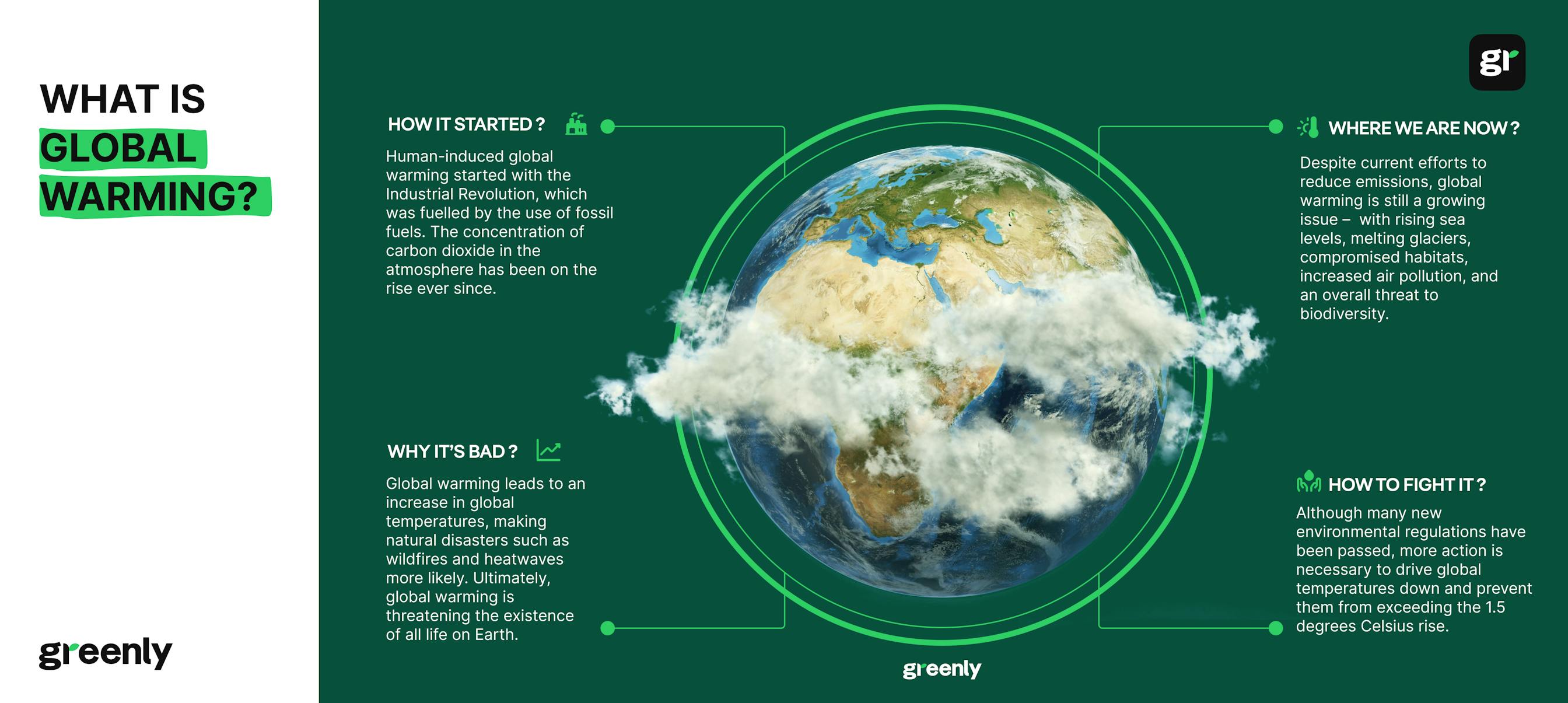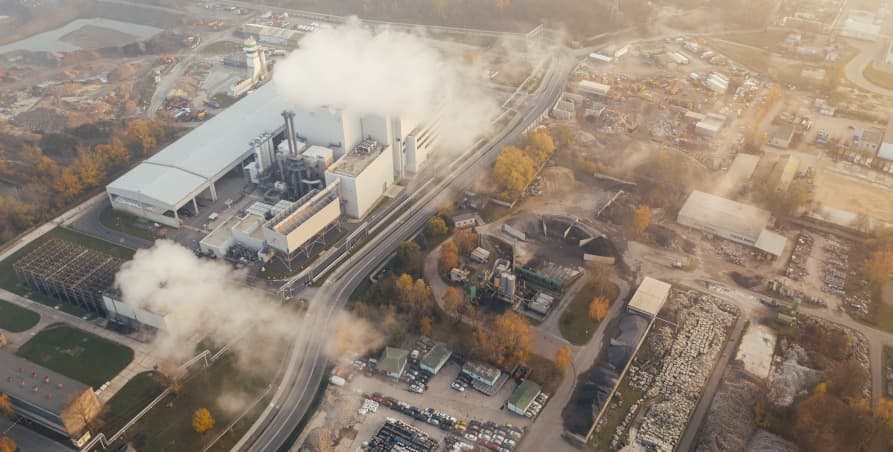
What are the 3 Pillars of Corporate Sustainability?
In this article, we'll explore what the 3 pillars of corporate responsibility are, why they're important, and how businesses can turn them into practical action.
ESG / CSR
Industries



In the wake headlining natural disasters, frequent public protests, and rising efforts to reduce carbon emissions and pave the way for a more sustainable future – many businesses are making an effort to go green: such as by abandoning the use of fossil fuels, shifting to renewable energy, giving up plastics, and more.
Ultimately, all of these efforts are meant to help business hit their reduction targets and also strive towards carbon neutral or net zero – as the main goal is to offset their ecological impact, in order to limit world temperature's rise and tackle climate change.


However, without sophisticated tracking and reporting in place such as a carbon tracker to help reduce your carbon footprint or improve supplier engagement – these announcements hold little weight.
When it comes to carbon footprints, the old business adage holds true: what gets measured gets managed. If you don’t have a clear picture of the size of your carbon footprint, and don’t know which activities are responsible for which portion of emissions – any claims for sustainability are about as helpful as declaring that your diet starts tomorrow.
In this article, we’ll dive deep into carbon technologies, explaining the difference between tracking and reporting, breaking down how emissions are calculated, and analyzing why measurement and reporting are essential for achieving corporate emissions targets and staying on track with CSR and ESG commitments.

Carbon tracking is a comprehensive way to measure and track carbon emissions from both direct emissions and indirect emissions. It allows businesses to calculate the greenhouse gas emissions that result from every one of their business activities, and get a clear picture of their footprint and the best opportunities for making reductions.
Carbon tracking is key to success for companies looking to save money, reduce their ecological footprint, better understand emission factors, avoid excess carbon dioxide emissions, and most importantly – if they want to demonstrate themselves as a sustainable company to the global community.
Carbon reporting comes after tracking, and it simply means publishing the data you’ve collected. This helps to set benchmarks for reporting, and creates transparency both internally and externally, and allows for clearer inter-company comparisons.
Ideally, reporting isn’t a one-off activity: it’s a quarterly, bi-annual or annual document produced in a standard format, that then allows your company and other people interested in its climate impact to map your progress and see whether you’re delivering on your promises.
The timeline below will reveal the sequence in which carbon reporting takes places after carbon tracking to develop a robust carbon reduction strategy and boost overall transparency:
After carbon tracking, collected data is reviewed to ensure completeness and accuracy.
Emissions are grouped into Scopes 1, 2, and 3 to reflect direct and indirect sources.
Carbon data is analyzed to identify key hotspots and areas for decarbonization.
Emissions performance is compared to peers and industry standards for context.
Actionable carbon reduction strategies are created based on the analysis results.
Findings are compiled into formal reports (e.g., GHG Protocol, CDP, CSRD) for stakeholders.
Emissions and progress are monitored regularly to ensure continuous improvement and transparency.
Carbon tracking and reporting are important as they both can help to support overall efforts towards improved sustainability in business.
Here are a few reasons why carbon tracking and carbon reporting are important:
The table below will further demonstrate the ways in which carbon tracking and reporting can prove useful:
| Benefit | Description |
|---|---|
| Regulatory Compliance | Ensures organizations meet environmental laws and carbon emissions regulations. |
| Cost Savings | Identifies energy inefficiencies, leading to reduced operational costs. |
| Corporate Reputation | Enhances brand image by demonstrating sustainability efforts to customers and stakeholders. |
| Investment & Funding | Attracts investors looking for environmentally responsible companies. |
| Risk Management | Helps mitigate risks associated with future carbon pricing and regulations. |
| Supply Chain Optimization | Encourages sustainable practices throughout the supply chain. |
| Employee & Customer Engagement | Inspires eco-conscious behavior among employees and attracts sustainability-minded customers. |
It's important to remember that the best emissions reports will not only deal with measurements or disclosures for total gas emissions, but also provide a breakdown of which activities and areas the business is most responsible – often aiming to include a specific percentage of emissions.
Furthermore, the best carbon reports will provide an analysis and report on the way to improvement, how they plan to set new goals, and readjust existing ones based on new insights. Lastly, they'll highlight new areas of opportunity for the future, and also look at opportunities for offsetting essential emissions.
Carbon tracking works by helping organizations to establish an effective method to monitor and measure greenhouse gas emissions. As a result, companies dedicated to carbon tracking will have access to the full scope of their current environmental impact and be able to adjust their sustainability strategies accordingly.
If all of this sounds like a complicated, it's because it is – but the good news is, measurement and reporting can easily be a done-for-you service. As a company looking to measure and limit its emissions, it doesn’t have to be complicated from your end – that’s our job!
Third party software and technologies like Greenly's carbon tracker will help you analyze your Scope 1, 2, and 3 emissions on a daily basis, and create a custom plan for emissions reduction. While your company gets down to business with reducing emissions, Greenly can also help you find verified carbon offsets for investment.



Carbon tracking and reporting are paramount in order to stay accountable to your emissions targets.
Here are 7 reasons why companies of all shapes and sizes should commit to carbon tracking to ensure long-term sustainability and transparency remain intact:
We’re used to corporations and country governments making lofty promises when it comes to reducing emissions, but an emissions target — without the right structures and measurements in place to measure progress and bring it to fruition — is just an empty promise (and could lead to greenwashing).
Carbon accounting turns carbon emissions data into numeric equivalents, making your emissions quantifiable. Putting your footprint into objective metrics gives you a clear picture of where you’re at, and helps you set realistic targets and define the steps needed to achieve them.
For example, when Amazon committed to achieving zero emissions by 2040, this was supported by a commitment to regular reporting, as well as implementing decarbonization strategies and investing in credible offset schemes.
The drop down sections below will reveal other companies that have backed up their environmental claims as a result of carbon tracking and reporting:
When companies report publicly on their data and progress year on year, this creates the necessary framework for greater accountability.
Pressure from investors, stakeholders, employees and consumers acts as an effective incentive for corporations to deliver on their climate pledges.
Even if reports reveal that a company is struggling or has failed to achieve their targets, the benefit of collecting and disclosing climate-related data is that the data can usually uncover where the project went wrong, and how to improve it in the future.
Though it isn't mandatory for many companies yet, many governments - and investors - are already requiring that certain large corporations track and report on carbon emissions.
The European Union, for example, requires large companies (including financial institutions like banks, insurance and listed companies) to publish regular reports on the social and environmental impacts of their activities.
With many other countries and organizations soon following suit (including the SEC’s newly proposed climate disclosure rule), as well as consumers, it’s smart to stay ahead of the curve, anticipate legal constraints, and start tracking greenhouse gas emissions across as many or all areas of your business – if possible.
The interactive flip cards below (move cursor over card to flip) will reveal some of the current disclosures already in place that signal how carbon reporting will become a requirement for all businesses in the future:
These days, we’re skeptical of bold promises, but won over by data. If your company plans to make environmental commitments, the only way to ensure consumers, stakeholders and employees are actually invested in and supportive of your efforts is to disclose your environmental impact data in regular reports.
Consistently reporting on your way towards your net zero targets, as well as admitting and analyzing your failures when they happen, has a great importance. It is an extremely effective way to build a culture of trust, and demonstrate transparency internally and externally.
A climate declaration is one thing, but regular reporting on your climate change progress can be an enormous asset for your brand image. When the world is exhausted by offset scams, greenwashing scandals and vague, empty statements, transparency over exactly how much carbon your company emits is a way to answer the demand for confidence. This can help your business win over new customers, and secure the loyalty of existing ones.
If you’re B2B, it also opens new opportunities for companies looking specifically for quality and sustainable providers, and if you’re publicly listed or looking for funding, ESG investing has never been more popular.
In other words: your brand becomes more competitive in its respective market, by contributing to limit global warming.
The overview cards below will reveal some of the ways that carbon tracking can help to improve your brand image:
Transparent carbon data helps your brand earn credibility with consumers, investors, and regulators.
More investors are looking at ESG metrics. Carbon tracking makes your business more attractive.
Media loves measurable action. Clear reporting gives journalists something worth sharing.
People want to support sustainable brands. Show them how you're reducing your footprint.
In a sea of greenwashing, carbon tracking helps you back up your claims with real data.
Suppliers and B2B clients are looking for accountability. Carbon data builds stronger collaborations.
When you conduct a carbon assessment, you’ll often find that your most polluting expenses come from Scope 3 — your supply chain.
Switching to carbon-light providers can make an enormous difference to your company’s carbon footprint, even though these emissions are considered indirect, rather than direct
It’s estimated that about 90% of a company’s greenhouse gas emissions come from its supply chain. Therefore, if you want to shift to sustainability model – don’t ignore Scope 3! In addition to this, switching to more carbon-friendly suppliers — such as renewable energy providers — often has the effect of being more financially friendly, too.
And carbon assessments don’t just reveal opportunities for emissions savings. Inevitably, when you calculate your carbon footprint, you produce a full audit of all your business activities, logistics, and expenses.
This is the kind of audit that might not happen when you’re simply operating in "business-as-usual" mode, but it can reveal incredible opportunities for your business (that aren’t necessarily carbon-related).
When you analyze every inch of your business activities, you’re bound to uncover ways to optimize your business' production and processes, reduce turnover, cut down on waste, improve efficiency, and build better products.
The summary cards below will reveal 4 different ways that carbon tracking could help to optimize your business model and turnover:
The summary cards below will reveal 4 different ways that carbon tracking could help to optimize your business model and turnover:
By identifying energy-intensive areas, carbon tracking highlights where to cut waste and save money on utilities and production costs.
Pinpointing high-emission suppliers helps optimize procurement strategies, improve logistics, and reduce inefficiencies.
Access new markets and eco-conscious clients by offering greener products and meeting sustainability criteria.
Consumers and B2B clients prefer responsible businesses. Showing your carbon efforts builds loyalty and long-term trust.
Ultimately, your company will experience better financial performance by making use of carbon tracking.

The best way to start reducing your company’s carbon emissions is — wait for it — to track your carbon footprint. Shocking, we know – but it’s true.
Conducting a rigorous carbon footprint assessment will show you, very quickly, the highest-leverage areas of your business for making emissions changes. These are the places where large amounts of emissions can be cut, with little investment and minimal disruption to business as usual.
Getting proper carbon accounting systems set up for the long-term is equally essential, because as your business changes and grows, so will its emissions breakdown. Receiving up-to-date information on which activities and areas are causing the most carbon emissions is the best way to keep your carbon footprint in check.
If you haven’t started carbon accounting or tracking yet, and you’re looking for some quick wins to reduce your footprint today, here’s a short list of some of our top recommendations.
If you look closely, you’ll notice that most of our recommendations for reducing company emissions look very similar to reducing emissions in your personal life. Climate science is complicated, but at the end of the day – cutting down on your carbon footprint isn't all that hard to do.
Just like you do at home, be conscious of the energy you use within your company. Look for quick wins — for example, do office lights need to be left on at night? Can computers and equipment be unplugged when they’re not in use? Can you replace existing light bulbs with more energy-efficient ones, or turn off heating/cooling when no one’s there?
Even better, switch to an energy provider that shifts from fossil fuels to renewable energy (at least to some degree). If you’re building a new office or facility, opt for low-carbon construction with efficiency measures built in, such as triple-glazed windows, modern insulation, rooftop solar panels, and sustainable building materials
Additional ways to reduce your energy consumption include:
Be mindful of how energy is used in the workplace. Simple switches like turning off lights or unplugging devices can add up quickly.
When not in use, unplug computers, monitors, printers, and other office equipment to avoid phantom energy use.
Replace old lighting with LEDs or energy-saving bulbs to reduce long-term electricity use without sacrificing brightness.
Switch off HVAC systems outside work hours and optimize thermostat settings to reduce unnecessary energy drain.
Choose a provider that sources from wind, solar, or hydro. Even partial shifts away from fossil fuels can make a difference.
For new offices or renovations, opt for energy-efficient building design — insulation, solar panels, and eco-friendly materials.
Triple-glazed windows and improved insulation reduce heating and cooling demands all year round.
Use smart meters or monitoring tools to identify high-consumption areas and adjust usage patterns accordingly.
Start small: dim hallway lights, enable sleep mode on devices, or hold energy-saving challenges across teams.
This one’s an easy one made even more popular by the pandemic. These days, virtual events can replace conferences, video meetings can replace in-person get-togethers, and working from home can cut down on commute- and office-related emissions.
If 100% remote work isn’t for your company, there are other ways you can minimize the impact of staff business travel, such as offering compensation for public transport, organizing car pooling opportunities, and installing electric vehicle charging stations on your premises.
Just like the close-to-home holidays inspired by the pandemic, one of the best things you can do for sustainability is to keep it local.
Whether you’re sourcing new materials or hunting for consultants, searching for local options first can help drastically cut down on unnecessary transport-related emissions, and can also help you forge strong partnerships and strengthen local communities.
The interactive flip cards below (move cursor over card to flip) will reveal some ideas on how to keep your company's operations as local as possible:
Consumption (particularly unnecessary consumption) is an enormous contributor to our global carbon footprint. Buying things we don’t need is an unequivocal problem, because it means carbon emissions and natural resources are used up, and it means those things are often thrown away (and end up in landfill).
Therefore, be mindful regarding your company’s consumption, only buy products when you actually need them, and wherever possible – buy second-hand, or buy products made from recycled and sustainable materials.
The waste your company produces can make up a significant portion of its carbon footprint, without bringing any of the benefits. It is, quite literally, money — and carbon — down the drain (or, more accurately into landfill). Just like with their carbon emissions, companies need to be thinking about reducing their waste materials to the absolute bare minimum.
They can do this by first reusing as many materials as possible. It’s easy to think you’re already doing this, but often a re-assessment of your company’s waste can lead to some innovative and cost-saving reuse solutions. Even if your company can’t reuse the materials, perhaps there’s another company or organization that can
After that, recycling is the next best step. Look for ways to recycle as many of your company’s individual waste materials as possible.

A: No, carbon tracking and carbon reporting are not one and the same – but they work in conjunction to demonstrate an organization’s commitment to monitoring and measuring carbon emissions. Carbon tracking is the process of collecting data and understanding the source of emissions, while carbon reporting is a breakdown of this data – completed after tracking.
A: Greenly is an excellent choice for companies looking to commit to carbon tracking and reporting. Our platform offers detailed scope emissions tracking, personalized support from climate experts, user-friendly dashboards, audit-ready reporting, and full compliance assistance with evolving regulations like the CSRD and SBTi.
A: Yes! Greenly helps companies not only track emissions but build effective, personalized reduction plans. With white papers, blog articles, and dynamic dashboards, our platform empowers businesses of all sizes to adopt low-carbon initiatives and long-term sustainability strategies.
If reading this article about carbon tracking has made you interested in reducing your carbon emissions to further fight against climate change – Greenly can help you!
Working to fight against climate change can be difficult, but don’t worry – Greenly is here to help. Click here to schedule a demo to see how Greenly can help you find ways to improve energy efficiency and decrease the dependency on fossil fuels in your own company.
Greenly can help you make an environmental change for the better, starting with a carbon footprint assessment to know how much carbon emissions your company produces.